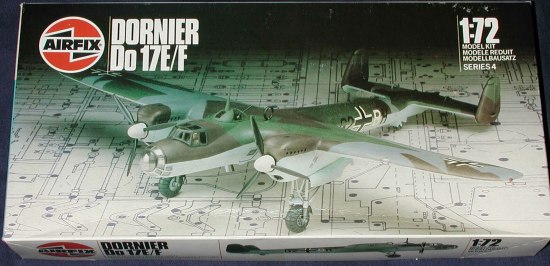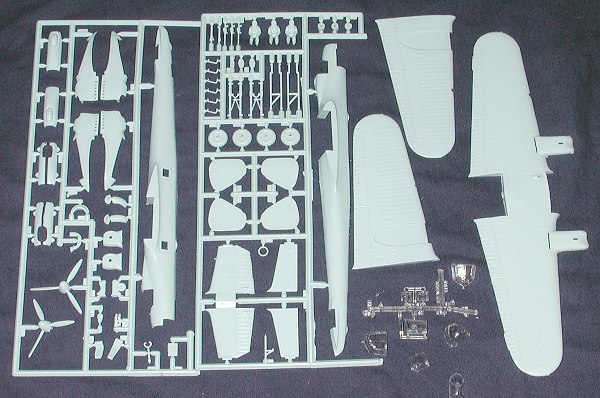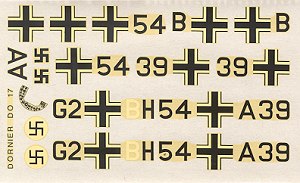
|
KIT: |
Airfix 1/72 Do-17E/F |
|
KIT # |
4014 |
|
PRICE: |
£ |
|
DECALS: |
Two Aircraft |
|
REVIEWER: |
|
|
NOTES: |
Not currently in the catalogue |

|
HISTORY |
Later Do 17s were built with 1,050 h.p. Daimler Benz DB.600G motors. With them the top speed went up to 470 km.h. (292 m.p.h.) at 14,800 ft. The Do 17 and later Do 215/217 aircraft were all-metal high wing cantilever monoplanes . They had twin fins and rudders at the ends of the cantilever tail plane just outboard of the centre-lines of the engines.
The original long tapered nose gained the Do 17 the name
of the "Flying Pencil." It was flush
riveted to further enhance its speed. The wings were without dihedral and
tapered towards the tip. The fully monocoque fuselage had an aluminum stressed
skin covering. The full cantilever tail plane is set at a small dihedral
angle. Trim tabs are used on all the movable control surfaces. The elevators
are mass balanced with external balances, which passed through slots in the
tail plane. The twin rudders had aerodynamic as well as mass balances. The
fixed surfaces have metal covering, the movable surfaces fabric.
The undercarriage is retracted hydraulically. The wheels, mounted between two oleo legs and equipped with mudguards and brakes, were raised backwards in to the motor nacelles and enclosed by hinged doors, so that only the tire was left protruding. This feature prevented many a 'wheels up' landing from doing a great deal of damage to the underside of the plane. While not all types had a retractable tail wheel, on those that did, the tail wheel retracted vertically in to the fuselage.
The Do 17 carried a crew of three, all in front of the
wing. The pilot sat on the port side of the fuselage, so that there was room
for the bomb-aimer to pass to his prone position below. A navigation
compartment with hinged chart table occupied the space between the back of the
pilot and the front spar of the wing.
Forward armament consisted of two fixed machine guns in
the front cowling, operated by the pilot. The bombs are stowed horizontally in
the centre section of the fuselage between the spars. Up to 1,000 kg. (2,205
lb.) can be carried internally. The Do 215 was built on the same jigs as the
Do 17 and only varied from it in minor detail.
They were robust enough to endure terrible amounts of gunfire, especially
small calibre gunfire. Their strength did not depend upon bracing wires and
wooden spars: these metal bombers had armour protection, with some of the
vital mechanical parts duplicated. Even more valuable were the self sealing
fuel tanks.
First combat was in Spain with the Legion Condor where the type was quite
successful against an ever-diminishing enemy air force and their Soviet
I-15/I-16 fighters. They were also quite successful in the opening year of the
war in Europe, but when faced against a determined enemy were not as immune as
the crews would have wished. By mid-war, the Do-17 was out of active service
on most fronts with the later 215 and 217 operating in small numbers and
mostly at night.
|
THE KIT |

Old time modelers will immediately recognize the light blue plastic as being an Airfix kit. However, this is one of the 'newer' moldings as you can see from the lack of separate control surfaces that were for such a long time the standard goodie to be added to Airfix kits. Instead, you have a pretty accurate, though sparsely detailed model kit. Well, perhaps it isn't that sparsely done, but it really needs an interior and some wheel well detail as that is barely adequate by today's standards. The interior has a floor, seats, control column and three figures. The surface features of the model are raised and there are the still requisite rivets where needed, rather odd in a flush-riveted aircraft, but hey, that's the 60s for you! In other regards the model is really rather well done. Yeah, the fabric on the control surfaces is a bit saggy and the decals have yellowed over time, but you do have the option of building it with the wheels up as a separate set of closed main gear doors are provided. You also have the option of building it as an E or F. The main difference in the kit being the windscreen, which on the bomber version (or E model) has a spot for an extra machine gun. The E also has a bomb sight and fairing that the F doesn't have.
 Instructions are the usual set
of construction drawings and are really quite good at providing the proper
building sequence and other construction information. Full color information
(including interior and other parts ) is provided on the back of the sheet, but
they are all in generic terms, the use of RLM colors in instructions not being
in vogue during the 60's. Markings are provided for an E and F in prewar units
and with prewar splinter color schemes of RLM 61/62/63 over RLM 65. Though the
pattern is the same on both planes, the colors used in those patterns is
different. No unit information is given. I'd be on the look for alternate decals
or at least raid the decal spares bin as the kit ones are less than optimal,
having yellowed over time. Included on the decal sheet is an instrument panel
decal that will be quite helpful.
Instructions are the usual set
of construction drawings and are really quite good at providing the proper
building sequence and other construction information. Full color information
(including interior and other parts ) is provided on the back of the sheet, but
they are all in generic terms, the use of RLM colors in instructions not being
in vogue during the 60's. Markings are provided for an E and F in prewar units
and with prewar splinter color schemes of RLM 61/62/63 over RLM 65. Though the
pattern is the same on both planes, the colors used in those patterns is
different. No unit information is given. I'd be on the look for alternate decals
or at least raid the decal spares bin as the kit ones are less than optimal,
having yellowed over time. Included on the decal sheet is an instrument panel
decal that will be quite helpful.
|
CONCLUSIONS |
Despite the age of the kit, it is pretty clean with only a trace of flash, no real problems with ejector pin marks and almost no sink areas that one usually finds in old kits. This is a kit that I do believe will build into a very nice model. Only problems I can see may be masking or gluing the clear bits as these are usually dodgy on old Airfix kits anyway. If you can find an etched brass fix-up set, then you can have a super model of a pre-war Luftwaffe bomber.
If you would like your product reviewed fairly and quickly by a site that has 200,000 visitors a month, please contact me or see other details in the Note to Contributors.